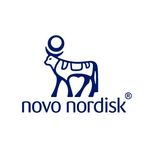Novo Nordisk Faces a Storm: CagriSema Trial Results Sink Shares
December 20, 2024, 10:22 pm
In the high-stakes world of pharmaceuticals, expectations can soar as high as a kite. But when reality strikes, the fall can be swift and brutal. Novo Nordisk, a titan in the obesity drug market, recently faced such a reckoning. The company’s experimental drug, CagriSema, was supposed to be the next big thing, a successor to its blockbuster Wegovy. Instead, it delivered a disappointing punch, sending shares tumbling and wiping out a staggering $125 billion in market value.
The results of the late-stage trial were unveiled on December 20, 2024. Investors had been holding their breath, hoping for a miracle. They anticipated a weight loss of 25% from CagriSema, a combination of semaglutide and cagrilintide. Instead, the drug only helped patients shed 22.7% of their weight after 68 weeks. The news hit like a thunderclap. Shares plummeted by as much as 27%, marking one of the most significant one-day losses for a European company in recent history.
CagriSema was positioned as a heavyweight contender in the obesity treatment arena, where competition is fierce. Eli Lilly’s Zepbound, a rival drug, had already shown promising results, leading to an average weight loss of nearly 23%. The stakes were high, and the pressure was palpable. Analysts had expected CagriSema to outshine its competitors, but the results fell short, raising questions about Novo’s future in the obesity market.
The trial involved approximately 3,400 participants, all grappling with obesity. These individuals had a body mass index (BMI) of 30 or above, or a BMI of 27 with at least one weight-related health issue. The findings revealed that while 40.4% of participants lost 25% or more of their weight, the overall average was not enough to satisfy investors. The disappointment was palpable, and the market reacted swiftly.
Novo Nordisk’s executives attempted to put a positive spin on the results. They highlighted that if all patients adhered to the treatment, the average weight loss could be seen as a success. However, this perspective did little to assuage investor fears. The stark reality was that the trial did not meet the ambitious targets set by the company. Analysts criticized Novo for setting expectations too high, suggesting that a more conservative approach might have mitigated the fallout.
The aftermath of the trial results was a whirlwind of speculation and analysis. Some investors expressed concern over the tolerability of CagriSema. Reports indicated that a significant number of patients did not complete the trial on the highest dose, raising red flags about potential side effects. Gastrointestinal issues were the most common adverse events reported, mirroring the side effects seen with other GLP-1 drugs already on the market.
Despite the disappointing trial results, some analysts believe that CagriSema still holds potential. They argue that the drug could be commercially viable in the long run, even if it didn’t meet initial expectations. The obesity drug market is projected to be worth around $150 billion globally by the early 2030s, and Novo Nordisk is keen to maintain its foothold in this lucrative sector.
In the wake of the trial, Novo Nordisk announced plans for a new trial in 2025 to further explore CagriSema’s weight-loss potential. The company aims to submit the drug for regulatory approval by the end of 2025. This move indicates that Novo is not ready to throw in the towel just yet. They remain committed to refining their approach and addressing the shortcomings highlighted in the recent trial.
The share price reaction, while severe, may not fully reflect the underlying fundamentals of the company. Some analysts argue that the market overreacted, suggesting that the long-term prospects for CagriSema could still be bright. However, the immediate impact was undeniable. The Danish crown weakened in response to the plunge in shares, highlighting the broader economic implications of the trial results.
Novo Nordisk’s journey in the obesity drug market has been a rollercoaster ride. The success of Wegovy catapulted the company to new heights, making it Europe’s largest company by market capitalization. But with great success comes great pressure. The company must now navigate the turbulent waters of investor expectations and competitive threats.
As the dust settles from the CagriSema trial, the future remains uncertain. Novo Nordisk faces a critical juncture. Will they rise from the ashes, or will this setback mark the beginning of a downward spiral? The answers lie in their ability to adapt, innovate, and ultimately deliver on the promises made to investors and patients alike.
In the world of pharmaceuticals, hope and disappointment often dance a delicate waltz. For Novo Nordisk, the next steps will be crucial. The company must not only recover from this setback but also prove that it can still lead the charge in the fight against obesity. The stakes are high, and the clock is ticking. The journey ahead will be watched closely by investors, analysts, and patients alike. The battle for the future of obesity treatment is far from over.
The results of the late-stage trial were unveiled on December 20, 2024. Investors had been holding their breath, hoping for a miracle. They anticipated a weight loss of 25% from CagriSema, a combination of semaglutide and cagrilintide. Instead, the drug only helped patients shed 22.7% of their weight after 68 weeks. The news hit like a thunderclap. Shares plummeted by as much as 27%, marking one of the most significant one-day losses for a European company in recent history.
CagriSema was positioned as a heavyweight contender in the obesity treatment arena, where competition is fierce. Eli Lilly’s Zepbound, a rival drug, had already shown promising results, leading to an average weight loss of nearly 23%. The stakes were high, and the pressure was palpable. Analysts had expected CagriSema to outshine its competitors, but the results fell short, raising questions about Novo’s future in the obesity market.
The trial involved approximately 3,400 participants, all grappling with obesity. These individuals had a body mass index (BMI) of 30 or above, or a BMI of 27 with at least one weight-related health issue. The findings revealed that while 40.4% of participants lost 25% or more of their weight, the overall average was not enough to satisfy investors. The disappointment was palpable, and the market reacted swiftly.
Novo Nordisk’s executives attempted to put a positive spin on the results. They highlighted that if all patients adhered to the treatment, the average weight loss could be seen as a success. However, this perspective did little to assuage investor fears. The stark reality was that the trial did not meet the ambitious targets set by the company. Analysts criticized Novo for setting expectations too high, suggesting that a more conservative approach might have mitigated the fallout.
The aftermath of the trial results was a whirlwind of speculation and analysis. Some investors expressed concern over the tolerability of CagriSema. Reports indicated that a significant number of patients did not complete the trial on the highest dose, raising red flags about potential side effects. Gastrointestinal issues were the most common adverse events reported, mirroring the side effects seen with other GLP-1 drugs already on the market.
Despite the disappointing trial results, some analysts believe that CagriSema still holds potential. They argue that the drug could be commercially viable in the long run, even if it didn’t meet initial expectations. The obesity drug market is projected to be worth around $150 billion globally by the early 2030s, and Novo Nordisk is keen to maintain its foothold in this lucrative sector.
In the wake of the trial, Novo Nordisk announced plans for a new trial in 2025 to further explore CagriSema’s weight-loss potential. The company aims to submit the drug for regulatory approval by the end of 2025. This move indicates that Novo is not ready to throw in the towel just yet. They remain committed to refining their approach and addressing the shortcomings highlighted in the recent trial.
The share price reaction, while severe, may not fully reflect the underlying fundamentals of the company. Some analysts argue that the market overreacted, suggesting that the long-term prospects for CagriSema could still be bright. However, the immediate impact was undeniable. The Danish crown weakened in response to the plunge in shares, highlighting the broader economic implications of the trial results.
Novo Nordisk’s journey in the obesity drug market has been a rollercoaster ride. The success of Wegovy catapulted the company to new heights, making it Europe’s largest company by market capitalization. But with great success comes great pressure. The company must now navigate the turbulent waters of investor expectations and competitive threats.
As the dust settles from the CagriSema trial, the future remains uncertain. Novo Nordisk faces a critical juncture. Will they rise from the ashes, or will this setback mark the beginning of a downward spiral? The answers lie in their ability to adapt, innovate, and ultimately deliver on the promises made to investors and patients alike.
In the world of pharmaceuticals, hope and disappointment often dance a delicate waltz. For Novo Nordisk, the next steps will be crucial. The company must not only recover from this setback but also prove that it can still lead the charge in the fight against obesity. The stakes are high, and the clock is ticking. The journey ahead will be watched closely by investors, analysts, and patients alike. The battle for the future of obesity treatment is far from over.

